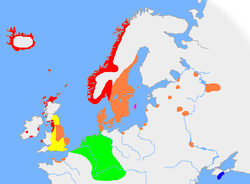- Old Gutnish
-
The approximate extent of Old Norse and related languages in the early 10th century:
 Old West Norse dialectOld East Norse dialectOld Gutnish dialectOther Germanic languages with which Old Norse still retained some mutual intelligibility
Old West Norse dialectOld East Norse dialectOld Gutnish dialectOther Germanic languages with which Old Norse still retained some mutual intelligibility
This article is part of a series on:
Old NorseDialects- Old West Norse
- (Old Icelandic · Old Norwegian · Greenlandic Norse)
- Old East Norse
- (Old Danish · Old Swedish)
- Old Gutnish
Use- Orthography
- Runic alphabet
- (Younger Futhark · Medieval)
- Latin alphabet
- Grammar
- Phonology
- Morphology
LiteratureAncestorsOld Gutnish was the dialect of Old Norse that was spoken on the Baltic island of Gotland. It shows sufficient differences from the Old East Norse dialect (also called Old Swedish or Old Danish) that it is considered to be a separate branch. Today a modern version, Gutnish, is still spoken in some parts of Gotland and on the adjoining island of Fårö.
The root Gut is identical to Goth, and it is often remarked that the language has similarities with the Gothic language. These similarities have led scholars such as Elias Wessén and Dietrich Hofmann to suggest that it is most closely related to Gothic. The most well-known example of such a similarity is that Gothic and Gutnish called both adult and young sheep lamb.
The Old Norse diphthong au (e.g. auga "eye") remained in Old Gutnish and Old West Norse, while in Old East Norse — except for peripheral dialects — it evolved into the monophthong ǿ, i.e. a long version of ǿ. Likewise the diphthong ai in bain (bone) remained in Old Gutnish while it in Old West Norse became ei as in bein and in Old East Norse it became é (bén). Whereas Old West Norse had the ey diphthong and Old East Norse evolved the monophthong ǿ) Old Gutnish had oy.
Proto-Germanic Old Gutnish Old West Norse Old East Norse *augon (eye)
*baino (bone)
*hauzjan (hear)auga
bain
hoyraauga
bein
heyraauga > ǿga
bæin > bén
høyra > hǿraMost of the corpus of Old Gutnish is found in the Gutasaga from the 13th century.
Language sample
Citation:
- Þissi þieluar hafþi ann sun sum hit hafþi. En hafþa cuna hit huita stierna þaun tu bygþu fyrsti agutlandi fyrstu nat sum þaun saman suafu þa droymdi hennj draumbr. So sum þrir ormar warin slungnir saman j barmj hennar Oc þytti hennj sum þair scriþin yr barmi hennar. þinna draum segþi han firi hasþa bonda sinum hann riaþ dravm þinna so. Alt ir baugum bundit bo land al þitta warþa oc faum þria syni aiga. þaim gaf hann namn allum o fydum. guti al gutland aigha graipr al annar haita Oc gunfiaun þriþi. þair sciptu siþan gutlandi i þria þriþiunga. So at graipr þann elzti laut norþasta þriþiung oc guti miþal þriþiung En gunfiaun þann yngsti laut sunnarsta. siþan af þissum þrim aucaþis fulc j gutlandi som mikit um langan tima at land elptj þaim ai alla fyþa þa lutaþu þair bort af landi huert þriþia þiauþ so at alt sculdu þair aiga oc miþ sir bort hafa sum þair vfan iorþar attu.
Employing normalised Old Norse orthography:
- Þissi Þjelvar hafði ann sun sum hít Hafði. En Hafða kuna hít Hvítastjerna. Þaun tú byggðu fyrsti á Gutlandi. Fyrstu nátt sum þaun saman sváfu þá droymdi henni draumr; só sum þrír ormar varin slungnir saman í barmi hennar, ok þýtti henni sum þair skriðin ýr barmi hennar. Þinna draum segði han firi Hafða bónda sínum. Hann raið draum þinna só: "Alt ir baugum bundit, bóland al þitta varða uk fáum þría syni aiga." Þaim gaf hann namn, allum ófýddum; Guti, al Gutland aiga; Graipr, al annar haita; ok Gunnfjaun þriði. Þair skiptu síðan Gutlandi í þría þriðjunga, só at Graipr þann eldsti laut norðasta þriðjung, ok Guti miðal þriðjung, en Gunnfjaun þann yngsti laut sunnarsta. Síðan, af þissum þrim aukaðis fulk í Gutlandi sum mikit um langan tíma at land elpti þaim ai alla fýða. Þá lutaðu þair bort af landi hvert þriðja þjauð só at alt skuldu þair aiga ok mið sír bort hafa sum þair ufan jorðar áttu.
Translation:
- This Thielvar had a son called Hafthi. And Hafthi's wife was called Whitestar. Those two were the first to settle on Gotland. When they slept on the island for the first night, she dreamed that three snakes lay in her lap. She told this to Hafthi. He interpreted her dream and said: "Everything is bound with bangles, this island will be inhabited, and you will bear three sons." Although, they were not yet born, he named them Guti, who would own the island, Graip and Gunfiaun. The sons divided the island into three regions, and Graip, who was the eldest, took the north, Guti the middle, and Gunfjaun, who was the youngest, took the southern third. After a long time, their descendants became so numerous that the island could not support all of them. They drew lots and every third islander had to leave. They could keep everything they owned but the land.
References
- Nationalencyklopedin
- Christine Peel. "Guta Saga - The History of the Gotlanders," Viking Society for Northern Research Text Series. Vol. XII. Viking Society for Northern Research, University College of London (1999).
Germanic languages · Germanic philology Language subgroups Reconstructed Proto-Germanic · Proto-Germanic grammarHistorical languages NorthEastWestModern languages Afrikaans · Alemannic · Danish · Dutch · English · Faroese · German · Gutnish · Icelandic · Limburgish · Low German · Luxembourgish · North Frisian · Norwegian · Saterland Frisian · Scots · Swedish · Vilamovian · West Frisian · YiddishDiachronic features Synchronic features Language histories Categories:- Gotland
- Gothic writing
- North Germanic languages
- Old Norse language
Wikimedia Foundation. 2010.

